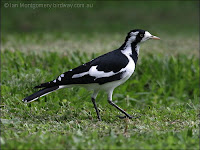On my way over to the Park, I had already picked up one lifer courtesy of tree martins flying over the downtown railway tracks. I had struggled over separating them from fairy martins but been sure enough of their identification. Either way the list had clocked 857 but the floodgates were not about to open.
For instance, my pre-trip research in Birmingham Library had included a copy of John Bransbury’s Where to Find Birds, which had assured me of little wattlebird at the Gardens. This is a honeyeater and is now called western wattlebird, having been split from its eastern cousin; I had seen that back in 2003. To be fair the book is quarter of a century out of date, which did show many times, if not in the disappearance of various sites, then at least of the species expected at them. The wattlebird was one of the latter. Moreover, my week in the species’ territory couldn't even rustle up one individual. My honeyeater sub-quest would get off to a rocky start.
Cheekily scavenging round the Botanical Café, red wattlebirds were plentiful, along with handsome western magpies, an entirely white-backed race of Australian magpie. The surrounding lawns held strutting magpie-larks. It seemed that any black-and-white bird down under got the “magpie” label. These bold birds became my constant companions throughout the breadth of Australia, excepting Tasmania, which would also distinguish itself in other ways.
Thus far the bird identification had been easy – galahs, grey fantails, silvereyes and ravens included. Maned and black ducks, coots, a kookaburra with a rat-sized rodent in its bill, and a rainbow bee-eater would also be no serious challenge. For a beginning birdwatcher the Botanic Gardens are marvellous, holding a good but not overwhelming selection. However, for the purist, one bird was cryptic. ⇐ ⇒





No comments:
Post a Comment